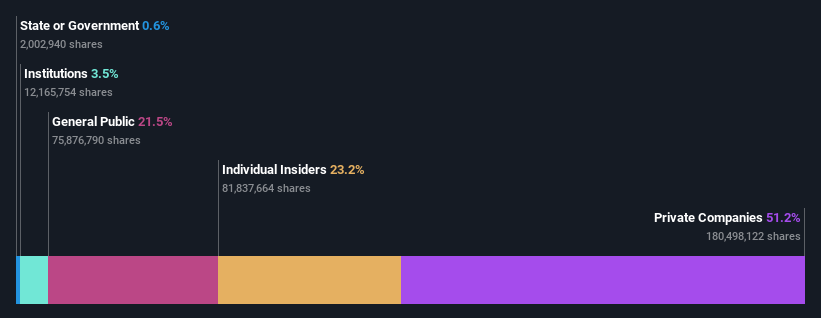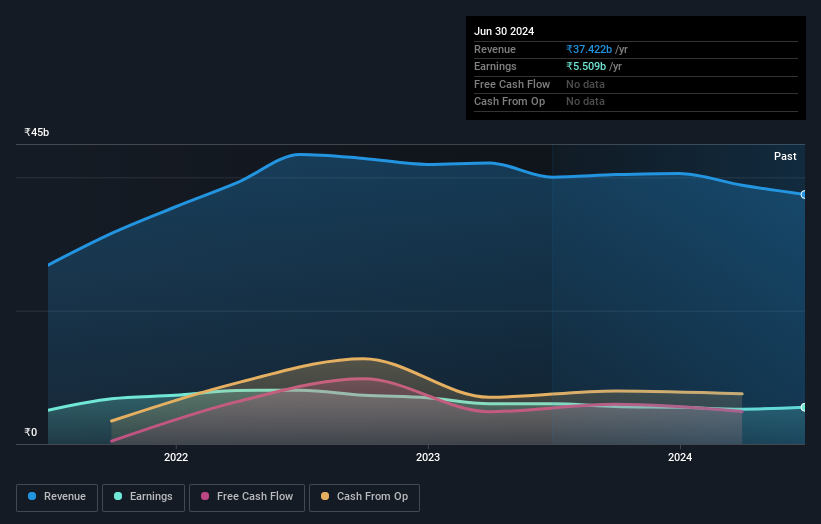- India
- /
- Metals and Mining
- /
- NSEI:SARDAEN
Sarda Energy & Minerals Limited's (NSE:SARDAEN) 6.3% gain last week benefited both private companies who own 51% as well as insiders

Key Insights
- Significant control over Sarda Energy & Minerals by private companies implies that the general public has more power to influence management and governance-related decisions
- The top 3 shareholders own 53% of the company
- Insiders own 23% of Sarda Energy & Minerals
To get a sense of who is truly in control of Sarda Energy & Minerals Limited (NSE:SARDAEN), it is important to understand the ownership structure of the business. With 51% stake, private companies possess the maximum shares in the company. In other words, the group stands to gain the most (or lose the most) from their investment into the company.
While private companies were the group that benefitted the most from last week’s ₹9.6b market cap gain, insiders too had a 23% share in those profits.
Let's take a closer look to see what the different types of shareholders can tell us about Sarda Energy & Minerals.
View our latest analysis for Sarda Energy & Minerals

What Does The Institutional Ownership Tell Us About Sarda Energy & Minerals?
Many institutions measure their performance against an index that approximates the local market. So they usually pay more attention to companies that are included in major indices.
Less than 5% of Sarda Energy & Minerals is held by institutional investors. This suggests that some funds have the company in their sights, but many have not yet bought shares in it. If the business gets stronger from here, we could see a situation where more institutions are keen to buy. We sometimes see a rising share price when a few big institutions want to buy a certain stock at the same time. The history of earnings and revenue, which you can see below, could be helpful in considering if more institutional investors will want the stock. Of course, there are plenty of other factors to consider, too.

Sarda Energy & Minerals is not owned by hedge funds. Our data shows that Chhattisgarh Investments Limited is the largest shareholder with 39% of shares outstanding. Sarda Agriculture & Properties Pvt Ltd is the second largest shareholder owning 7.3% of common stock, and Uma Sarda holds about 6.2% of the company stock. Additionally, the company's CEO Kamal Sarda directly holds 1.8% of the total shares outstanding.
A more detailed study of the shareholder registry showed us that 3 of the top shareholders have a considerable amount of ownership in the company, via their 53% stake.
Researching institutional ownership is a good way to gauge and filter a stock's expected performance. The same can be achieved by studying analyst sentiments. As far as we can tell there isn't analyst coverage of the company, so it is probably flying under the radar.
Insider Ownership Of Sarda Energy & Minerals
While the precise definition of an insider can be subjective, almost everyone considers board members to be insiders. The company management answer to the board and the latter should represent the interests of shareholders. Notably, sometimes top-level managers are on the board themselves.
I generally consider insider ownership to be a good thing. However, on some occasions it makes it more difficult for other shareholders to hold the board accountable for decisions.
It seems insiders own a significant proportion of Sarda Energy & Minerals Limited. It has a market capitalization of just ₹162b, and insiders have ₹38b worth of shares in their own names. That's quite significant. Most would be pleased to see the board is investing alongside them. You may wish to access this free chart showing recent trading by insiders.
General Public Ownership
With a 22% ownership, the general public, mostly comprising of individual investors, have some degree of sway over Sarda Energy & Minerals. While this group can't necessarily call the shots, it can certainly have a real influence on how the company is run.
Private Company Ownership
Our data indicates that Private Companies hold 51%, of the company's shares. It might be worth looking deeper into this. If related parties, such as insiders, have an interest in one of these private companies, that should be disclosed in the annual report. Private companies may also have a strategic interest in the company.
Next Steps:
While it is well worth considering the different groups that own a company, there are other factors that are even more important.
I always like to check for a history of revenue growth. You can too, by accessing this free chart of historic revenue and earnings in this detailed graph.
Of course this may not be the best stock to buy. Therefore, you may wish to see our free collection of interesting prospects boasting favorable financials.
NB: Figures in this article are calculated using data from the last twelve months, which refer to the 12-month period ending on the last date of the month the financial statement is dated. This may not be consistent with full year annual report figures.
New: Manage All Your Stock Portfolios in One Place
We've created the ultimate portfolio companion for stock investors, and it's free.
• Connect an unlimited number of Portfolios and see your total in one currency
• Be alerted to new Warning Signs or Risks via email or mobile
• Track the Fair Value of your stocks
Have feedback on this article? Concerned about the content? Get in touch with us directly. Alternatively, email editorial-team (at) simplywallst.com.
This article by Simply Wall St is general in nature. We provide commentary based on historical data and analyst forecasts only using an unbiased methodology and our articles are not intended to be financial advice. It does not constitute a recommendation to buy or sell any stock, and does not take account of your objectives, or your financial situation. We aim to bring you long-term focused analysis driven by fundamental data. Note that our analysis may not factor in the latest price-sensitive company announcements or qualitative material. Simply Wall St has no position in any stocks mentioned.
About NSEI:SARDAEN
Flawless balance sheet with acceptable track record.


